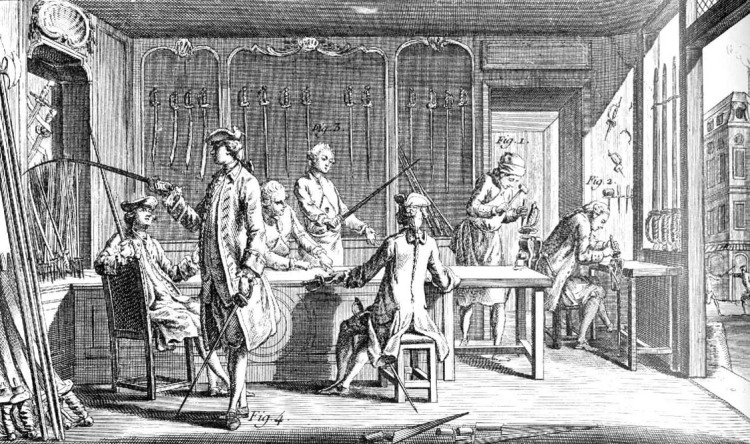We buy them for many reasons : for the sheet enjoyment of possessing them, for historical interest, and some for the practice of martial art or reenactment. Yet, there is one reason we will never be able to experience... purchasing a sword that is intended to do what swords were originally meant for : to defend life, and to take life. No,it is the highest unlikelyhood you will ever trust your very life to your sword. I have been researching this forgotten perspective lately. I teach historical fencing ,and will be giving a presentation at a local sword symposium about historical necessities that are no longer part of practicing the art of historical swordsmanship . One of the topics I am covering is the gentlemanly choosing of a sharp sword for dueling and defense purposes. Several historical treatises address this subject, but my chosen source is 17th century French fencing master Monsieur L'Abbate's Sur L' Art En Fait D'Armes , translated into English in 1734 as The Art of Fencing,or,The use of the Small Sword.
In the first chapter , L'Abbat gives us a very practical premise , as follows below :
" Courage and Skill being often of little use without a good Weapon, I think it necessary , before I lay down the Rules for using it, to shew how to chuse a good Blade ,and how it ought to be mounted..."
He later continues on ,giving his opinion on the proper methodology of choosing a good blade:
" ... In order to chuse a good blade, three Things are to be observed : First, that the Blade have no Flaw in it, especially across, it being more dangerous than Length-way. Secondly, That it be well tempered ,which you'll know by bending it against a wall or other Place; if it bend only towards the Point; 'tis faulty , but if it bend in a semi-circular Manner ,and the Blade spring back to Straightness, 'tis a good Sign; If it remains bent it is a Fault ,tho' not so great as if it did not bend at all; for a blade that bends being of a soft Temper, seldom breaks; but a stiff One being hard tempered is easily broke .."
The next section is what I am particularly interested in :
" The third Observation is to be made by Breaking the point, and if the Part broken be of a grey Colour , the Steel is good ; if it be White 'tis not : Or you may strike the Blade with a Key or other piece of Iron , and if he gives a clear Sound, there is no hidden fault in it.... "
So here, amonst other antiquated behaviors, we see a most curious practice . A gentleman would not be found at fault or thought abusive if he snapped the point off a sword he was interested in. Talk about tire kicking !
A few specific questions :
Is this practice of snapping off the point while selecting a sword as commonplace as L'Abbat seems to suggest? Or perhaps only a regional practice? ( L'Abbat lived in Toulouse, south-western France)
I suppose the tip could be reground with relative ease, but the idea still seems destructive ,considering the expense of a sword. Has this technique been documented in other works?
For those of you with knowledge of metalurgy, what is indicated by the steel color L'Abbat describes? All broken steel I have seen has been a grey color. What would 'white' coloration indicate about the heat treatment? Is that a flaw that does not exist in modern alloys? I've always thought in terms of grain structure, not coloration.
I am planning on actually breaking a sword tip as part of the presentation, so I would appreciate any input .
All thoughts on this topic is most encouraged !
